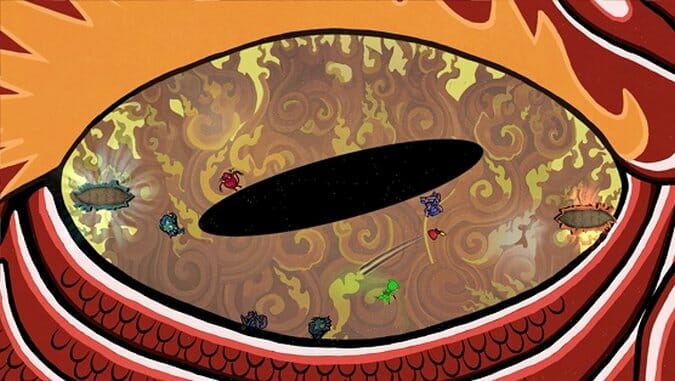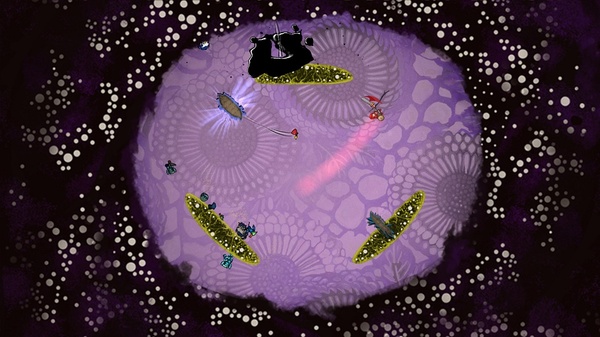
It’s unfair to discuss Paperbound without divulging the circumstances in which you played it. Experienced by yourself—let’s go ahead and admit this up front—it’s a miserable experience that makes you uncomfortably conscious of the time you are wasting, like staying indoors getting baked on a gorgeous summer day.
Paperbound is a 4-person, 2D “couch multiplayer brawler,” with the key word here being couch: there is no online play. You must have enough controllers and real-life friends willing to come over to play, and therein lies both the rub and the magic and greatness of the game.
After dithering around a bit playing against the AI bots that developer Dissident Logic literally suggests in their press material not to use if you can avoid it, I packed up my two PS4 controllers, and longboarded to a friend’s office where I knew he had his own PS4 hooked up and another two controllers. It was only under these circumstances that we managed, after inviting another guy at the office to join us, to get a three-man game going, with my wife showing up later to square out the group
This is when Paperbound suddenly became brilliant.
Paperbound, it should be said, has no story, at all. Nothing, not even an intro. This lack of narrative is somewhat ironic, given that the game’s 18 rather lovely-looking fighting arenas all take their themes from five wild books: Journey to the Center of the Earth, The Book of Five Rings, The Book of the Dead, Dante’s Inferno, and, er, Skull Kingdom (they invented that last one). The game’s host of characters are apparently also taken from these books, although I didn’t recognize any of them specifically (Ninjeddy? Mumsy?) You can also choose from a handful of characters from other indie games like Guacamelee or VVVVVV, but no character plays any differently than any of the others apart from aesthetic differences like running animation and the visuals of some of their attacks.
The weapons are tangentially literary too or at least relate to paper: you lob inkwell grenades, some characters’ swords are shaped like pencils, and everybody wields a sort of throwing star that is actually a pair of scissors. To be clear though, this is a twitch fest, not a drag-out Smash Bros.-style brawler; all of your weaponry—sword, shuriken and ink—cause instant death.
The game’s most interesting mechanic though is its use of gravity. Run towards a wall and you will soon find yourself running straight up it. Or, with a tap of the PS4 triangle button, your character’s gravity is reversed. So if you are running on the ceiling, you will fall, if you are on the left wall, a tap of the triangle will hurl you—only you, not the other players—towards the opposite wall. You are still capable of attacking and vulnerable to death as you fly across the screen, often with another player flying across the screen in another direction and swiping his sword at you as you pass.
We figured out that rapidly hitting the triangle button allows you to hover in the air or drift like a butterfly at your leisure. As fun as this is to do—and at first it felt like we had broken the game—ultimately this butterfly technique leaves you quite vulnerable, especially since your focus on mashing the triangle button slows your ability to react to an attack. But this tactic was useful on some maps in some game modes, particularly on the capture the flag mode (here called Capture the Quill) where your zigzagging motion could help you flee back towards your base while under fire. We also ended up using “the Flutter” to simply taunt another player at times.
Most of the game modes can be played either as free-for-alls or divided into 2v2 matches, although not every map is available for every game mode. Our group’s favorite ended up being survival; trying to knock down your opponents’ limited stock of lives, which always ends, of course, with a one-on-one showdown.
I managed to get in two evenings with a group of four players—and it was some of the best gaming I have experienced this year. Even my wife, who is not a gamer, loved the game, and was able to grasp the controls quickly enough that she and I as a team managed to get a win on Capture the Quill, and she even won a survival match herself by strategically laying low while the other three players knocked down each other’s stock of lives.
There was so much laughter and joy in our matches that my friends didn’t want to quit when I told them I had to go—even though we were playing at their place of work and their work day was long over. Hours after we finished playing my wife was in noticeably high spirits—she had been laughing so much while playing the game that it had elevated her mood. I realized that it wasn’t just Paperbound that had made us happy, it was the social interaction for which the game was a vehicle. It was designed as such. Dissident Logic only added AI at the very end of development. Paperbound was originally meant to have no option for single player—even though it is also releasing on PC, a notoriously barren place for local multiplayer experiences.
Dissident Logic’s initial instinct was correct; playing with the AI is a fruitless experience. The AI bots worked functionally in deathmatches, but when deeper strategy was involved, such as in Capture the Quill, they were stumped. On my first attempt I was able to beat the AI team 10-0 (there is no difficulty option). In all the game modes the AI bots will frequently stop moving and just stand there staring like morons.
Paperbound’s restrictions impelled me to seek out my friends and spend time with them and that is a worthy, if comparatively inconvenient, experience for a game to foster. If you can manage to wrangle up enough controllers and in-the-flesh human beings, a jolly experience awaits you. Otherwise—maybe skip buying the game and just go hang out with your friends.
Paperbound was developed by Dissident Logic. We played it on the Playstation 4. It is also available for PC.
Jagger Gravning is a writer whose work has appeared in The Atlantic, Kotaku, VICE, Motherboard and elsewhere. His feature screenplay Wallflower is currently being produced. Follow him on Twitter @GoForRainbow.
